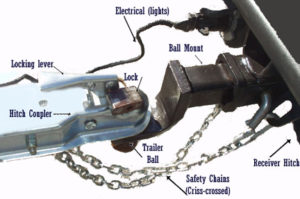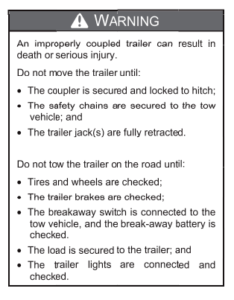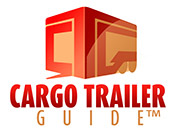Couple and uncouple your cargo trailer
*The following instructions should only be used as guidelines and are not meant to replace manufacture or trailer dealer’s instructions.
Coupling Your Trailer
A secure coupling (or fastening) to the tow vehicle is essential. A loss of coupling may result in serious injury or death. Therefore, you must understand how to properly couple your cargo trailer to your tow vehicle.

The following parts are involved in making a secure coupling between the trailer and the tow vehicle:
- Coupling: That part of the trailer connecting mechanism by which the connection is actually made to the trailer hitch. This does not include any structural member, extension of the trailer frame, or brake controller.
- Hitch: That part of the connecting mechanism including the ball support platform and ball and those components that extend and are attached to the towing vehicle, including bumpers intended to serve as hitches.
- Weight distributing hitch (equalizing hitch): A mechanical device that connects the trailer to the towing vehicle and by means of leverage applied to the trailer and towing vehicle structure, when properly adjusted, distributes the imposed vertical load at the hitch and coupling connection between structures of the towing vehicle and the trailer.
- Weight carrying hitch: A mechanical and/or structural device that connects the trailer to the towing vehicle and that does not employ features designed to redistribute the load imposed at the hitch and carrying connection.
- Safety chains or cables: Chains or cables permanently attached to the trailer such that if the coupler connection comes lose, the safety chains or cables can keep the trailer attached to the tow vehicle. With properly rigged safety chains or cable, it is possible to keep the tongue of the trailer from digging into the road pavement, even if the coupler-to-hitch connection comes apart. Some states do not allow safety cables. Therefore, it may be wise to check with the state police to see if your state has any restrictions on the use of safety cables, if your trailer is so equipped.
- Trailer lighting (and braking) connector: A device that connects electrical power from the tow vehicle to the trailer. Electricity is used to turn on brake lights, running lights, and turn signals as required. In addition, if your trailer has a braking system, the electrical connector will also supply power to the trailer brakes from the tow vehicle.
- Break-away switch: If the trailer becomes uncoupled from the towing vehicle, the break-away switch lanyard, attached independently to the tow vehicle, will pull a pin in the emergency electrical break-away switch on the trailer. The break-away switch is activated by a separate battery supply in the trailer such as to energize the trailer brakes independently of the towing vehicle. It is important to check the state of charge of the emergency break-away battery before each trip. Simply pull the pin out of the switch by hand and then try to pull the trailer forward. If you feel a significant drag force, then the brakes are activated. Be sure to re-insert the pin in the break-away switch. Also, be sure to allow enough slack in the break-away switch lanyard such that the switch will only activate (pin pulls out) if the trailer becomes uncoupled from the tow vehicle.
- Jack: A device on the trailer that is used to raise and lower the trailer tongue. On larger trailers it is sometimes called the “landing gear”. They are common on gooseneck cargo trailers.

